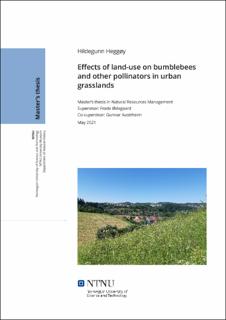| dc.contributor.advisor | Ødegaard, Frode | |
| dc.contributor.advisor | Austrheim, Gunnar | |
| dc.contributor.author | Heggøy, Hildegunn | |
| dc.date.accessioned | 2021-09-25T16:03:05Z | |
| dc.date.available | 2021-09-25T16:03:05Z | |
| dc.date.issued | 2021 | |
| dc.identifier | no.ntnu:inspera:79539604:15936949 | |
| dc.identifier.uri | https://hdl.handle.net/11250/2782481 | |
| dc.description.abstract | Semi-naturlege grasmarker er eit av dei viktigaste habitata for humler og andre pollinatorar, men endringar i arealbruk truer denne habitattypen. Opphøyr av skjøtsel, med påfølgande gjengroing er truleg ein av dei viktigaste truslane mot semi-naturlege grasmarker i dag. I tillegg har urbanisering ført til auka press, fragmentering og isolering av habitatflekkar, og urbane grønt-områder er sterkt modifisert. Slike arealbruksendringar fører til nedgang i diversiteten av pollinerande insekt og viktige blomsterressursar. I denne studien undersøkte me: (1) effektar av arealbruk på humler og andre pollinatorar i urbane grasmarker ved å samanlikne semi-naturlege grasmarker og suksessive grasmarker. (2) effekten av ulike faktorar, inkludert sesong, blomsterressursar og arealbruk i omkringliggande landskap, på antall av humler og andre pollinatorar. Generaliserte lineære blanda modeller vart brukt til å vurdere forholdet mellom pollinatorar og arealbruk, sesong, antall blomar, omkringliggande landskap, temperatur og skydekke. Ein NMDS-ordinasjonsanalyse vart brukt til å vurdere forholdet mellom samansetning av observerte pollinatorar, grasmarker og arealbruk.
Me fann at artsrikdom og antall av humler var signifikant forskjellig i semi-naturlege og suksessive grasmarker. Det var også ein signifikant forskjell i variasjonen av artar og antall av humler i dei to typane grasmarker, med høgast variasjon i semi-naturlege grasmarker. Totalt antall av pollinatorar var ikkje signifikant forskjellig i dei to typane grasmarker, heller ikkje variasjonen. Artsrikdom og antall av humler og andre pollinatorar auka gjennom sommaren, og mai og juni var signifikant forskjellig frå juli og august. Humler og andre pollinatorar var positivt påverka av auka antall blomar, større andel ikkje-habitat, og høgare temperatur. Ordinasjons-analysen viste ingen signifikant forskjell i arts samansetnad i semi-naturlege og suksessive grasmarker, men analysen viste samanhengar relatert til pollinatorars preferansar for habitat. Resultata i denne studien viser ein stor variasjon innanfor semi-naturlege grasmarker i Trondheim, med eit mangfald av vedlikehald og karaktertrekk. Riktig bevaringsarbeid av grasmarker og urbane grønt-areal kan bidra til auka diversitet av pollinatorar og plantar i framtida. I tillegg kan forvaltningstiltak som fremmer heterogenitet og konnektivitet på landskapsnivå vere viktig for å bevare biodiversitet av pollinatorar og plantar i urbane områder | |
| dc.description.abstract | Semi-natural grasslands are one of the most important habitats for bumblebees and other pollinator taxa, but changes in land use threaten this habitat type. Abandonment and subsequent encroachment of bushes and trees is considered one of the most important threats today. Additionally, urbanization has led to an increased pressure, fragmentation, and isolation of habitat patches, and urban green-space areas are managed intensively. These land-use changes are causing declining numbers and diversity of pollinators and important floral resources. In this study we examined: (1) effects of land use on bumblebees and other pollinator taxa in urban grasslands by comparing semi-natural and successional grasslands within the urban and suburban parts of Trondheim. (2) effects of various factors including season, land-use in the surrounding landscape, and flower species richness and abundance on species richness and abundance of bumblebees and other pollinator taxa. Generalized linear mixed models were used to assess the relationship between pollinators and land-use, seasons, flowers, surrounding landscape and weather conditions including temperature and cloud cover. A NMDS ordination analysis was used to assess the relationship between composition of observed pollinators, grasslands, and their land-use.
We found a significant difference in pollinator richness and abundance in semi-natural and successional grasslands. Similarly, there was a significant difference in variation of bumblebee abundance and species richness between semi-natural and successional grasslands, with a higher variation among the semi-natural grasslands. Total abundance of pollinators did not differ significantly between land-use types, neither did the variation. Number of pollinators increased during the summer, and numbers in May and June differed significantly from July and August. Bumblebees and other pollinators were positively affected by species richness and abundance of flowering plants, increasing proportion of non-habitat, and temperature. The ordination analysis showed no significant difference in species composition between land-use types, but revealed some pattern related to the different pollinators’ preferences for specific habitats. Results of this study indicate that Trondheim present a variety of characteristics among semi-natural grasslands and suggest that maintenance of the semi-natural grasslands’ characteristics is of importance for the conservation of urban pollinator- and plant communities. Additionally, management strategies promoting heterogeneity and connectivity at the landscape level can be important for the conservation of pollinators and plants in urban areas. | |
| dc.language | eng | |
| dc.publisher | NTNU | |
| dc.title | Effects of land-use on bumblebees and other pollinators in urban grasslands | |
| dc.type | Master thesis | |
